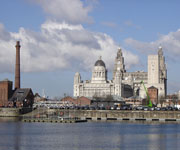Six areas in the historic centre and docklands of Liverpool bear witness to the development of one of the world's major trading centres in the 18th, 19th and early 20th centuries. A series of significant commercial, civic and public buildings lie within these areas, including the Pier Head, with its three principal waterfront buildings - the Royal Liver Building, the Cunard Building, and Port of Liverpool Building; the Dock area with its warehouses, dock walls, remnant canal system, docks and other facilities related to port activities; the mercantile area, with its shipping offices, produce exchanges, marine insurance offices, banks, inland warehouses and merchants houses, together with the William Brown Street Cultural Quarter, including St. George's Plateau, with its monumental cultural and civic buildings.

Continent: Europe
Country: United Kingdom
Category: Danger List
Criterion: (II) (III) (IV)
Date of Inscription: 2004
The maritime mercantile City of Liverpool
Located at the tidal mouth of the river Mersey where it meets the Irish Sea, the maritime mercantile City of Liverpool played an important role in the growth of the British Empire. It became the major port for the mass movement of people, including slaves and emigrants from northern Europe to America. Liverpool was a pioneer in the development of modern dock technology, transport systems and port management, and building construction.
 |
| Liverpool Maritime Mercantile City |










0 comments:
Post a Comment